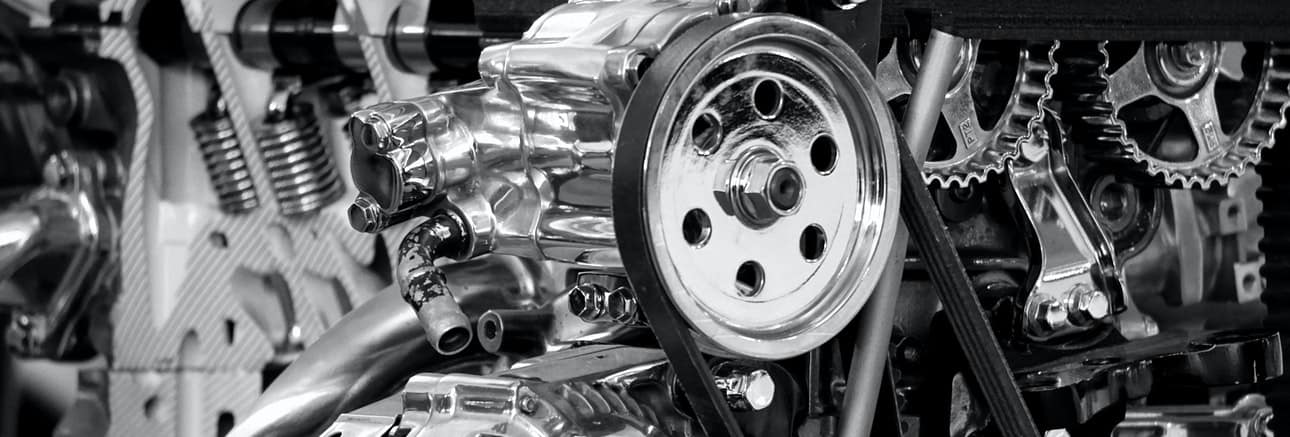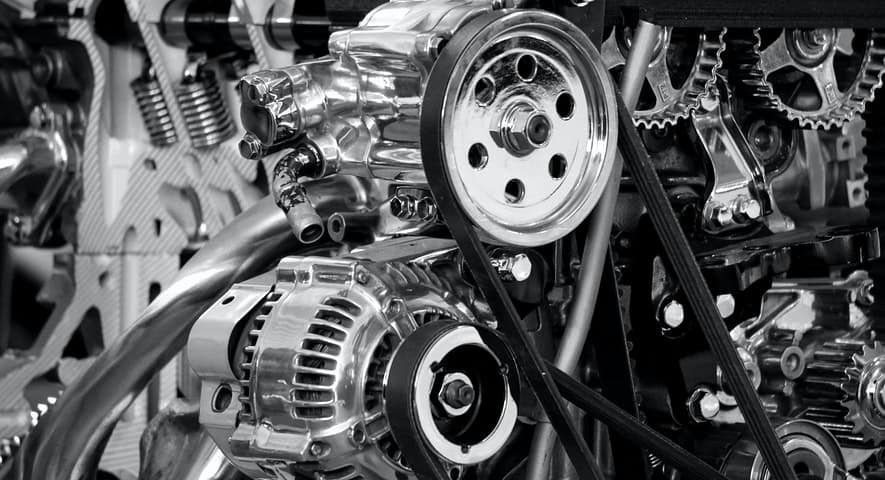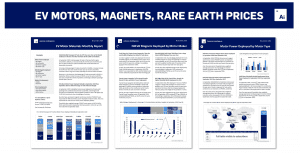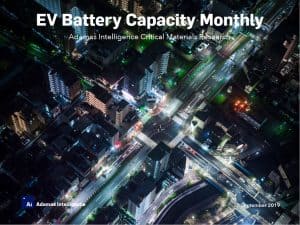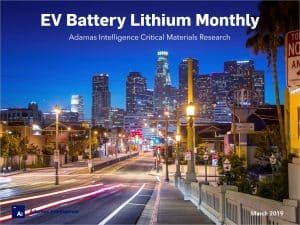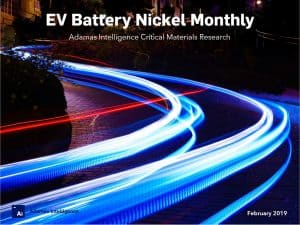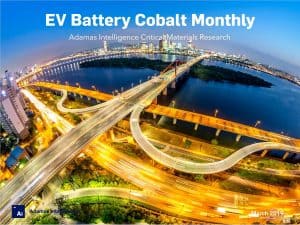EV Motor Materials Monthly Special Feature: Q&A with Niron Magnetics
Innovative Iron Nitride (“FeN”) Magnet Material
In late-January, Adamas Intelligence spoke with emerging U.S.-based permanent magnet producer, Niron Magnetics, about the company’s innovative iron nitride (“FeN”) magnet material for production of high performance, low-cost permanent magnets.
Adamas: Can you give us an overview of the historical work that has been done on iron nitride leading up to the founding of Niron Magnetics?
Niron: Steel nitriding has existed for more than a century, but the highly magnetic α”-Fe16N2 phase of iron nitride wasn’t synthesized until the 1950s by researchers who were looking for alternatives to carbon in steel manufacturing.
The ability to fabricate the material as a thin film was developed in the 1970’s and provided the first hints of iron nitride’s superior magnetic properties.
However, little further progress was made in understanding the underlying physics behind the superior performance of this material let alone producing it experimentally and it basically sat on the shelf for decades with only sporadic work being done.
In 2002 this grand challenge got the attention of Prof. Jian-Ping Wang, a physicist and material scientist at the Electrical and Computer Engineering Department at the University of Minnesota.
Professor Wang committed himself, with the assistance of eight of his PhD students, to untangling the mysteries of this material.
It turned into an eight-year fundamental research journey and ultimately enlisted the collaboration of research scientists at four US Department of Energy national research facilities (Oak Ridge, Argonne, Brookhaven, Los Alamos).
Prof Wang’s groundbreaking research got an additional boost in 2011 with the arrival of the first global rare earth crisis. Companies and governments were scrambling to deal with the sudden, dramatic 5x spike in rare earth prices. Within the US, the Department of Energy, under the ARPA-E program, started work to look for alternatives to rare earth elements in critical technologies, including magnets.
The University of Minnesota with the support from a research team of Oak Ridge national lab was awarded a project to develop a bulk permanent magnet based on iron nitride.
The ARPA-E -funded work yielded significant results, including the first validation of this material as a permanent magnet by four different synthesis methods and the confirmation of the material’s ultra-high magnetization – more than 50% higher than any known permanent magnetic compound.
Based on that work Niron Magnetics was formed in early 2015 and opened an industrial R&D facility in 2017 with an objective of commercializing iron nitride permanent magnets.
Adamas: What characteristics, traits and/or properties does iron nitride possess that make it commercially interesting?
Niron: Iron nitride has a very high magnetic flux density – the highest of any known compound. Flux density is proportional to torque density in motors and generators.
This means with our material designers can create smaller, lighter and more cost-effective devices than with designs based on other material technologies.
It also has very low reversible temperature coefficients which means that it holds its magnetic properties at very high and very low operating temperatures better than other materials.
Iron nitride, as its chemical name indicates, is made from two of the most common elements on earth – iron and nitrogen.
Unlike magnets made from rare earths and other critical materials, these materials are cheap, sustainable, globally available, made from broadly recycled materials and not subject to supply constraints or price instability.
Lastly, the process for making our magnets is on average two-thirds and as much as 95% less damaging to the environment than alternatives in large part because our input materials require no toxic mining.
That’s why we’ve trademarked the name Clean Earth Magnet for this new family of materials.
Adamas: Can you tell us about the Gen 1 and Gen 2 magnets Niron is currently developing?
Niron: We have two generations of magnets on our product roadmap.
We will be sampling our Gen 1 magnet this year. It will offer a remanence of approximately 0.9 Tesla and ought to be applicable to a wide range of products from audio transducers, magnetic sensors and consumer appliances to industrial motors and automotive accessory motors.
Our Gen 2 magnet is targeted for 2023 and will offer an industry leading remanence of 1.5 Tesla. It should be suitable for higher torque density applications and high operating temperatures – including electric vehicle drivetrains, wind turbines and eMobility applications.
Adamas: What advantages does iron nitride have over ferrite and NdFeB magnets?
Niron: The Clean Earth Magnet family fills a set of market gaps and resolves as set of material tradeoffs that have long existed and frustrated customers. Ferrite magnets are inexpensive to make but produce very low magnetic field strength.
The size of a device you can make using a permanent magnet is inversely proportional to the field strength. Consequently, devices made with ferrite are large, heavy and relatively inefficient.
NdFeB magnets produce high field strengths but pretty much everything else about them is problematic.
They are incredibly expensive, because rare earth elements are very difficult to extract and refine. The vast majority of the cost of producing an NdFeB magnet is the raw material mining and processing cost.
Today neodymium sells for over $100 per kilogram and dysprosium is over $400 per kilogram. In contrast, the recycled iron we use as raw material input costs less than $1 per kilogram.
NdFeB magnets lose their magnetic performance at higher operating temperatures requiring the addition of ever more problematic materials like dysprosium to compensate so the higher temperature grades are wildly expensive.
Niron’s Clean Earth Magnets, because of their unique crystalline structure, have far-superior temperature performance without the expensive additives.
But it’s more than just the cost and performance – our magnets are made from iron and nitrogen – two commodities that are globally available in huge quantities, so we don’t suffer from the problems associated with having to tie magnet production to a limited set of mines in a handful of geographies.
Those problems include huge swings in price and frequent supply restrictions. As long as magnet production represents three-quarters of the value of rare earth mining that’s going to be difficult to change.
We also have the advantage of being able to manufacture anywhere since we aren’t tied to the existing rare earth material supply chain.
This can have a significant favorable impact on logistics costs and supply chain responsiveness. In addition to being high-performance, inexpensive and based on a stable supply chain, Clean Earth magnets don’t entail the same environmental devastation and negative climate impacts of rare earth magnets, so you get a sustainable material without having to compromise performance.
Adamas: Niron recently announced a partnership with GM and Marquette University to develop drivetrains for EVs using rare earth free materials. Can you tell us more about that?
Niron: This fall we announced a collaboration, funded by the Department of Energy Vehicle Technology Office, to produce a vehicle drivetrain that meets or exceeds all the upcoming DOE EV motor specifications without the use of rare earths or other critical materials.
We’re very pleased to have GM as a partner in the program. The motor design work is being done at Marquette University where they have done a lot of highly innovative motor design work in leveraging new types of magnetic materials, including ours.
The program also includes the National Renewable Energy Lab and Virginia Tech University.
We expect to produce a motor that has as good or better torque, power and efficiency at a significantly lower cost compared to motors using rare earth magnets.
Adamas: Other than EV traction motors, what other commercial end-uses and applications is Niron targeting in the near-term? What end-use markets do you envision using iron nitride by the end of the decade?
Niron: As you know, the application space for magnets is vast and will at least double over the next decade – approaching $50 billion. As we’ve gotten into specific design studies with customers, we’ve been impressed with the breadth of applications we can serve. Many require only incremental design changes to realize the benefits while others require a bigger change in the device design concept. Like any new material you want to make sure the device design is optimized.
Right now, the design choices are highly compromised when it comes to magnetic materials. There will certainly be some applications where ferrite’s low price remains the dominant consideration, however we know that there are a large number of ferrite applications that have considered a higher strength magnet like NdFeB and couldn’t justify the huge price premium or price and supply instability. We close that “bucks per flux” gap dramatically and open up new design opportunities for products that use ferrite today.
Our product roadmap climbs the ladder of performance allowing us to replace NdFeB magnets initially on the basis of price performance and ultimately on the basis of absolute performance, so we believe the application space opens up pretty wide by the time we have our Gen 2 magnet sampling in 2023.
Also keep in mind that there are a gigantic set of motor applications (many times the size of the permanent magnet motor market) that don’t use permanent magnets today and instead use far less efficient induction or other non-permanent magnet motor designs.
Roughly 40% of electricity demand powers these sorts of motors and up to half of it is wasted due to motor and system inefficiencies. With a better magnet price-performance tradeoff, we believe we can unlock opportunities that grow the market for permanent magnet motors and contribute to reductions in greenhouse gas emissions through higher energy efficiency.
Our priorities for market segments right now are focused on applications that have rapid product cycles and customers who have an interest in market disruption. When you consider that many permanent magnet motors dedicate one third to one half their bill of materials to the magnets, a significant reduction in the magnet cost can drive a significant competitive advantage.
Adamas: What does the path ahead to commercial production look like for Niron? What, if any, challenges must be overcome?
We are launching construction of a scaled-up pilot facility now. That facility should be operational in late 2021 or early 2022. That will allow us to provide materials for the construction of prototype devices for evaluation and testing with a select set of customers.
After that we move to full-scale factories that can produce tens of thousands of tons in aggregate.
The manufacturing methods we have selected are all highly scalable and exist at thousand-ton scale today in service of other materials industries.
Of course, building and qualifying large-scale manufacturing is a significant engineering effort, so we expect and have planned for needing to resolve engineering issues as we stand up bigger and bigger facilities, but we don’t anticipate any fundamental barriers to getting that done.
Adamas: Thank you, Niron. We look forward to following your progress.
Adamas’ Take:
Niron’s iron nitride material is impressive and has potential to alleviate many of the price, supply, performance and environmental challenges associated with incumbent magnet materials, such as ferrite and NdFeB.
Homologation in the auto industry for mission-critical components like motors and batteries can take many years to complete so while we’re encouraged to see Niron working closely with GM, we believe it may be several years before we see iron nitride in the traction motors of EV makers.
In the meantime, we will watch closely how the market receives the company’s Gen 1 magnets, which we believe are well-suited for cost-sensitive applications like smart speakers, sensors and micromotors.
(Download this Q&A in PDF format)
More Data and Insights from Adamas Intelligence
Must-have intelligence for automakers, cell suppliers, battery materials manufacturers, miners, explorers, investors and other stakeholders with a professional interest in the EV, battery and battery materials industries.
We offer a number of interactive data tools and subscription-based reports for clients seeking regular updates, analysis, and insights into the fast-moving markets and supply chains that we cover.
EV Battery Capacity and Battery Metals Tracker
Building on ongoing EV registrations in over 80 countries, our web-based platform helps users track monthly deployment of battery metals and materials, battery capacity, and the ever-evolving competitive landscapes of battery chemistries and cell suppliers.
The tracker’s intuitive user interface and interactive charts and filters let users quickly zoom in on specific regions, countries, automakers, models, cell suppliers, battery chemistries, battery materials and more.
Subscription includes access to the online platform plus a wealth of Excel data, all updated monthly.
EV Motor Materials Monthly
Our new ‘EV Motor Materials Monthly’ is a subscription-based report and data service for tracking motor demand, NdFeB magnet demand, and other key developments in the global EV traction motor market month-after-month, as they happen; by region, country, motor type, EV type, EV make, EV model and motor supplier, plus the latest developments in rare earth and NdFeB alloy prices.
Every report contains a detailed snapshot of the latest monthly market data, plus an additional 12 months of historical data for context and comparison. All reported monthly data available to subscribers in Excel format.
EV Battery Capacity Monthly
Our ‘EV Battery Capacity Monthly’ is a subscription-based report and data service for tracking monthly deployment of battery capacity (in MWh) in passenger EV batteries by country, region, EV make, EV model, cell supplier, cell chemistry, EV type and more.
Every report contains a detailed snapshot of the latest monthly market data, plus an additional 12 months of historical data for context and comparison. All reported monthly data available to subscribers in Excel format.
EV Battery Lithium Monthly
Our ‘EV Battery Lithium Monthly’ is a subscription-based report and data service for tracking monthly deployment of lithium in passenger EV batteries by country, region, EV make, EV model, cell supplier, cell chemistry, EV type and more.
Every report contains a detailed snapshot of the latest monthly market data, plus an additional 12 months of historical data for context and comparison. All reported monthly data available to subscribers in Excel format.
EV Battery Nickel Monthly
Our ‘EV Battery Nickel Monthly’ is a subscription-based report and data service for tracking monthly deployment of nickel in passenger EV batteries by country, region, EV make, EV model, cell supplier, cell chemistry, EV type and more.
Every report contains a detailed snapshot of the latest monthly market data, plus an additional 12 months of historical data for context and comparison. All reported monthly data available to subscribers in Excel format.
EV Battery Cobalt Monthly
Our ‘EV Battery Cobalt Monthly’ is a subscription-based report and data service for tracking monthly deployment of cobalt in passenger EV batteries by country, region, EV make, EV model, cell supplier, cell chemistry, EV type and more.
Every report contains a detailed snapshot of the latest monthly market data, plus an additional 12 months of historical data for context and comparison. All reported monthly data available to subscribers in Excel format.
Back to overview

